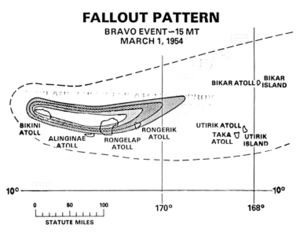Project 4.1
Project 4.1 was the designation for a medical study and experimentation conducted by the United States of those residents of the Marshall Islands purposefully exposed to radioactive fallout from the March 1, 1954 Castle Bravo nuclear test at Bikini Atoll, which had an unexpectedly large yield. Government and mainstream historical sources point to the study being organized on March 6 or March 7, 1954, six days after the Bravo shot.
Establishment and secrecy
In the wake of the Castle Bravo detonation, a new research section was added to the Castle Bravo Weapons Effects research section. Program 4, "Biomedical effects," was to include one project, Project 4.1, titled "Study of Response of Human Beings exposed to Significant Beta and Gamma Radiation due to Fall-out from High-Yield Weapons." Eugene P. Cronkite of the National Naval Medical Center was designated as Project Officer. Cronkite's instructions stressed the importance of secrecy surrounding the project:
- ... the project is classified SECRET RESTRICTED DATA. Due to possible adverse public reaction, you will specifically instruct all personnel in this project to be particularly careful not to discuss the purpose of this project and its background or findings with any except those who have specific "need to know."[2
The purpose of the project, as a 1982 Defense Nuclear Agency report explained, was both medical as well as for research purposes:
- The purposes of [Project 4.1] were to
- (1) evaluate the severity of radiation injury to the human beings exposed,
- (2) provide for all necessary medical care, and
- (3) conduct a scientific study of radiation injuries to human beings.
Preparation
As a Department of Energy Committee writing on the human radiation experiments wrote, "It appears to have been almost immediately apparent to the AEC and the Joint Task Force running the Castle series that research on radiation effects could be done in conjunction with the medical treatment of the exposed populations."[4] The DOE report also concluded that "The dual purpose of what is now a DOE medical program has led to a view by the Marshallese that they were being used as 'guinea pigs' in a 'radiation experiment.'
Organizations involved in the project included the Naval Medical Research Institute, the Naval Radiological Defense Laboratory, Patrol Squadron 29, the Naval Air Station, Kwajalein, Los Alamos National Laboratory, the Applied Fisheries Laboratory at the University of Washington, and Hanford Atomic Power Operations. Three U.S. Navy ships were used in the project: USS Nicholas, USS Renshaw, and USS Philip.[3] The primary study of the Marshallese was terminated around 75 days after the time of exposure. In July 1954 a meeting at the Division of Biology at the U.S. Atomic Energy Commission decided to complete 6- and 12-month follow-up exposure studies, some of which were later written up as addendums to Project 4.1.
Intentionality
Some Marshallese have alleged that the exposure of the Marshallese was premeditated. In 1972, Micronesian Representative Ataji Balos charged at the Congress of Micronesia that the exposure during Bravo was purposeful so that the AEC could develop medical capabilities for treating those exposed to fallout during nuclear war, and charged that the Marshallese were chosen because of their marginal status in the world at large. According to a U.S. internal transcription of Balos' talk, Balos alleged that "The U.S. chose to make guinea pigs out of our people because they are not white but some brown natives in some remote Pacific islands. Medical treatment that Rongelapese and Utrikese have been receiving is also highly questionable."[6] The AEC issued a staff comment denying these charges.
In 1994, a 1953 Castle Bravo program prospectus was found which included reference to Project 4.1 apparently written before the Bravo shot had occurred. The U.S. government responded that someone had gone back into the project list after the Bravo test to insert Project 4.1; thus, according to the U.S. government, the acts were not premeditated. All other U.S. documents point to Project 4.1 having been established after the Bravo test—most sources point to its having been organized on March 7, 1954.[7] The final Project 4.1 report began in its preface with the statement that "Operation CASTLE did not include a biomedical program" (it mentions this in discussing the ad hoc nature by which the project personnel were assembled).[8] All official and mainstream historical accounts of the Bravo test indicate that its high level of fallout was a result of a miscalculation in relation to its design and was not deliberate (see the Castle Bravo article for more information on the alleged accident).
Barton C. Hacker, the official historian of U.S. nuclear testing exposures (who is, in the end, very critical of the U.S. handling of the Bravo incident), characterized the controversy in the following way:
- In March 1954, the AEC had quickly decided that learning how the Marshallese victims of Castle Bravo responded to their accidental exposure could be of immense medical and military value. Immediate action centered on seeing them evacuated and decontaminated, then cared for medically. But studies of their exposures and aftereffects also began. That effort became project 4.1 in the Castle experimental program. This unfortunate choice of terminology may help explain later charges that the AEC had deliberately exposed the Marshallese to observe the effects. Like the American radium dial painters of the 1920s and the Japanese of Hiroshima and Nagasaki in 1945, the Marshallese of 1954 inadvertently were to provide otherwise unobtainable data on the human consequences of high radiation exposures. Findings from project 4.1 soon began to appear in print. Barton C. Hacker, Elements of controversy: the Atomic Energy Commission and radiation safety in nuclear weapons testing, 1947-1974
- More information is available at [ Wikipedia:Project_4.1 ]
Chat rooms • What links here • Copyright info • Contact information • Category:Root
